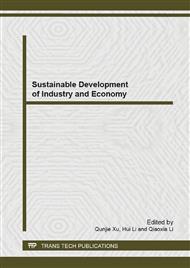p.758
p.762
p.766
p.773
p.777
p.781
p.786
p.791
p.796
Industrial Restructuring and Emission Reduction
Abstract:
The most essential way to realize the goals in emission reduction is to speed up industrial restructuring and promote the transformation of economic growth pattern. This article collected four-digit indexes concerning industrial restructuring in 30 provinces (cities, regions) in China from 1999 to 2007 to show the extent of industrial restructuring in that area. And then it matched these figures to those of environmental pollution on provincial level. This way, it would be able to see how manufacturing industrys inner restructuring affects the emission. The results showed that Chinas industrial restructuring had led to a significant decrease in the emission per unit of GDP.
Info:
Periodical:
Pages:
777-780
Citation:
Online since:
December 2013
Authors:
Keywords:
Price:
Сopyright:
© 2014 Trans Tech Publications Ltd. All Rights Reserved
Share:
Citation:


